Yoga for Women’s Health: Soothing Yoga Sequence to Ease Menstrual Discomfort
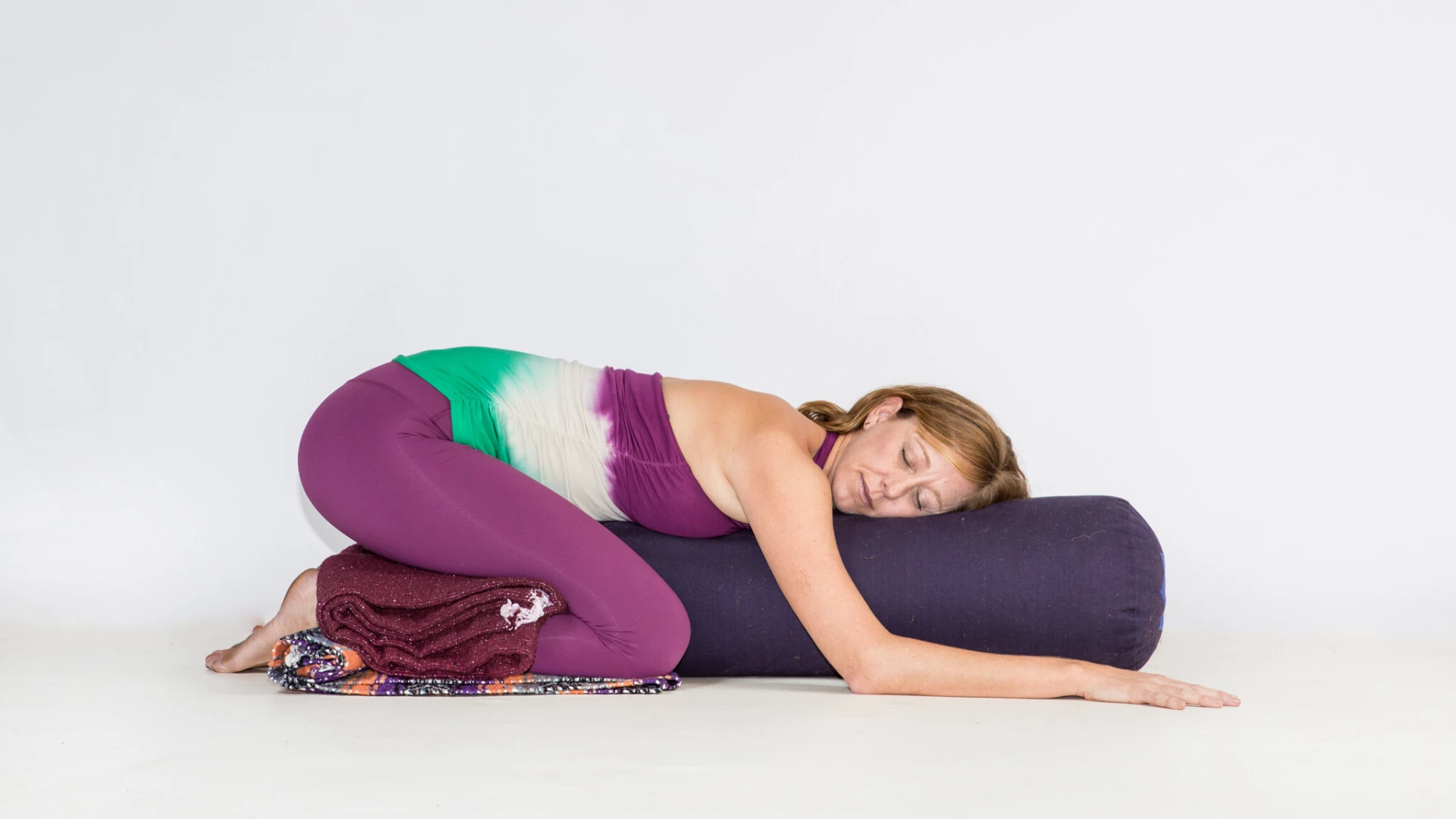
Whether it’s fatigue, moodiness, headaches, bloating, nausea, abdominal cramps, low back pain, or any lovely combination of said symptoms ranging from moderate to severe—almost all women experience some form of discomfort during menstruation. It isn’t a particularly pleasant time of the month; however, it is one during which we can honor (dare I say celebrate?!) our feminine nature by turning inward and implementing more self-nurturing, restorative practices.
While you certainly can keep going to your regular yoga class, depending on your symptoms, you may not feel up to practicing at full speed for the first few days of your cycle, especially if you suffer from dysmenorrhea (a.k.a. painful periods) like me. Even getting from the couch to my mat can be a stretch on particularly bad days. However, I know that if I can get to the floor and do some gentle movements, simple stretches, and at least one restorative pose, I will feel slightly to significantly better, depending on the day.
Below is a series of yoga poses that can be done during menstruation to help relieve some of your discomfort. You will need a yoga block, and a bolster or a few pillows will work, too. Try the entire sequence, or pick one or two poses that seem doable and go from there.
Yoga Sequence to Ease Menstrual Discomfort
1. Cat/Cow Poses
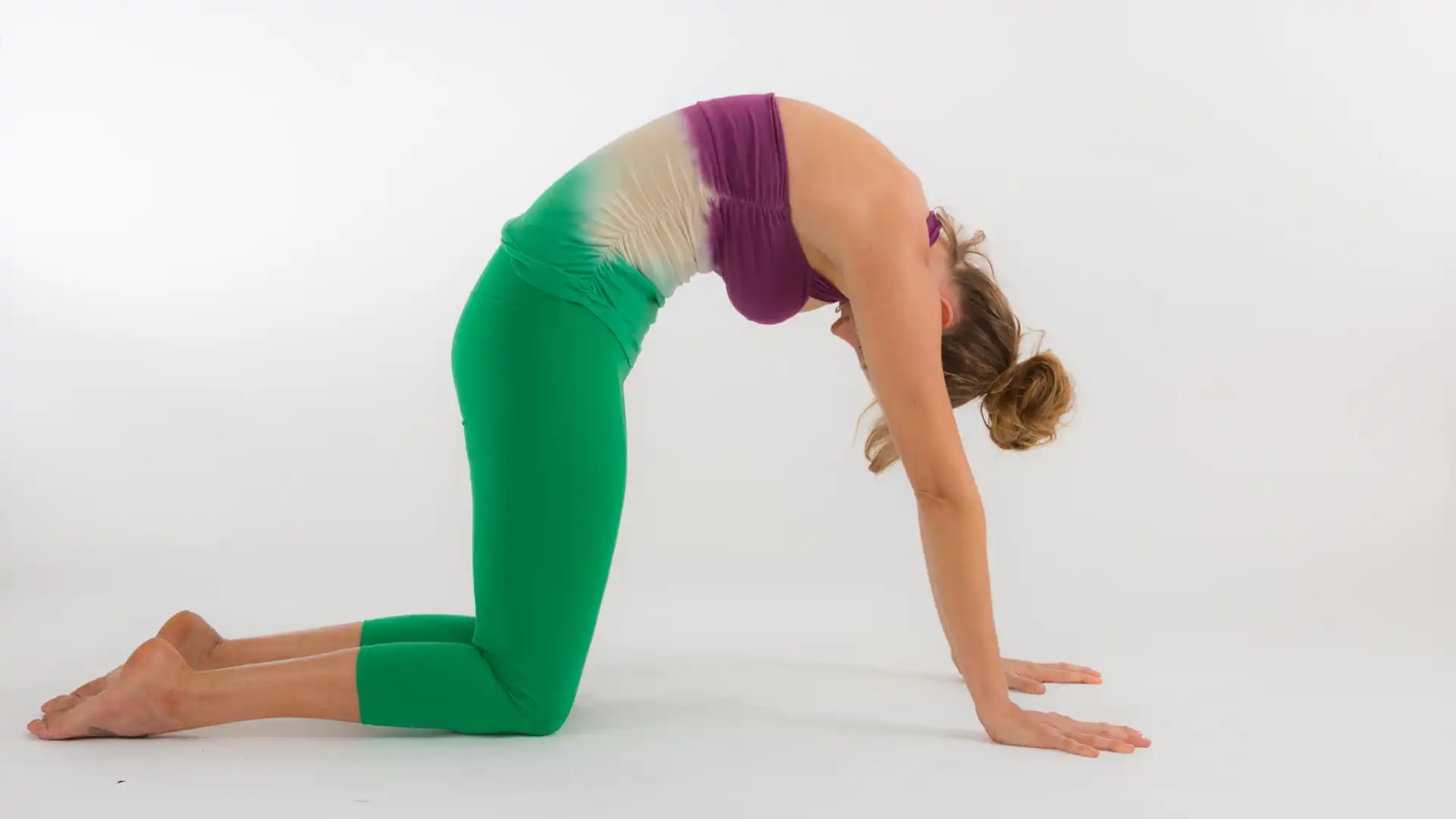
1. If you can uncurl from a fetal position and manage to get down to your hands and knees in a tabletop position for a few Cat/Cow poses and gentle hip circles, your body will thank you for it. Rather than staying contracted, lengthening your spine, tilting your pelvis (as well as your uterus), and moving your hips in some Cat/Cow-type motions will begin to invite the abdomen, hip flexors, and lower back to release.
2. While you’re at it, try a few circles through your hips, shifting your weight to one side, circling your hips back by your heels and coming up through the opposite side. Start slowly, really feeling through your outer hips and side bodies, allowing the circles to get larger if you like, and don’t forget to change the direction.
2. Supported Child’s Pose Variation
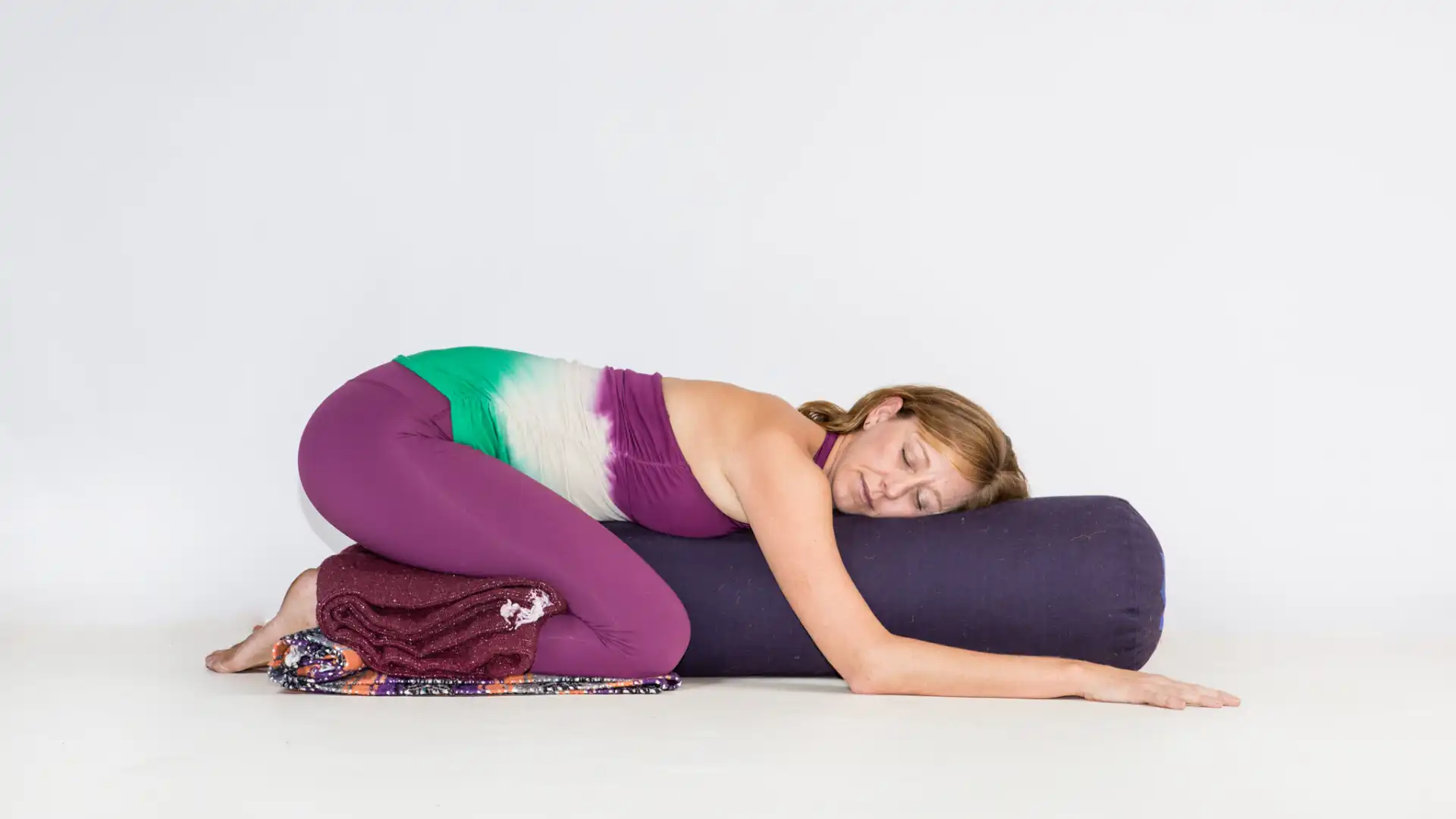
1. From the Tabletop position on your hands and knees, place the bolster or pillows lengthwise underneath your head and chest.
2. For the traditional Child’s Pose, rather than lowering your sitting bones toward your heels, keep your bottom high over your knees and slowly lower your head and chest down to the bolster, turning your head to one side and allowing your elbows to rest on either side of the bolster.
This variation of Child’s Pose tilts the pelvis and uterus so that the hip flexors can relax, the abdomen can soften, and all of the muscles 360 degrees around the pelvis can be released. As the muscles around the pelvis and abdomen soften, cramps caused by uterine contractions will begin to ease up.
3. Stay in the position, taking deeper breaths as you release more, or feel free to lower your sitting bones toward your heels for a more traditional child’s pose.
3. Supported Low Lunge or Lizard Pose

1. Coming back up to your hands and knees in tabletop position, step your right foot forward between your hands and then bring your right arm inside your right leg, heel-toeing your right foot slightly wider than your right hip.
2. Gently lower both elbows to the floor or onto your block or bolster.
3. Release your back toes, pointing your back foot, and place a blanket or cushion under your back knee as necessary. Lizard Pose takes you deeper into the hip flexors and pelvic muscles.
4. Take a minimum of five to seven breaths, and then slowly straighten your arms and bring your right knee back under your right hip in the table-top position.
5. You may want to do a few gentle hip circles or Cat-Cows before switching sides and stepping your left foot forward.
4. Bound Angle Pose
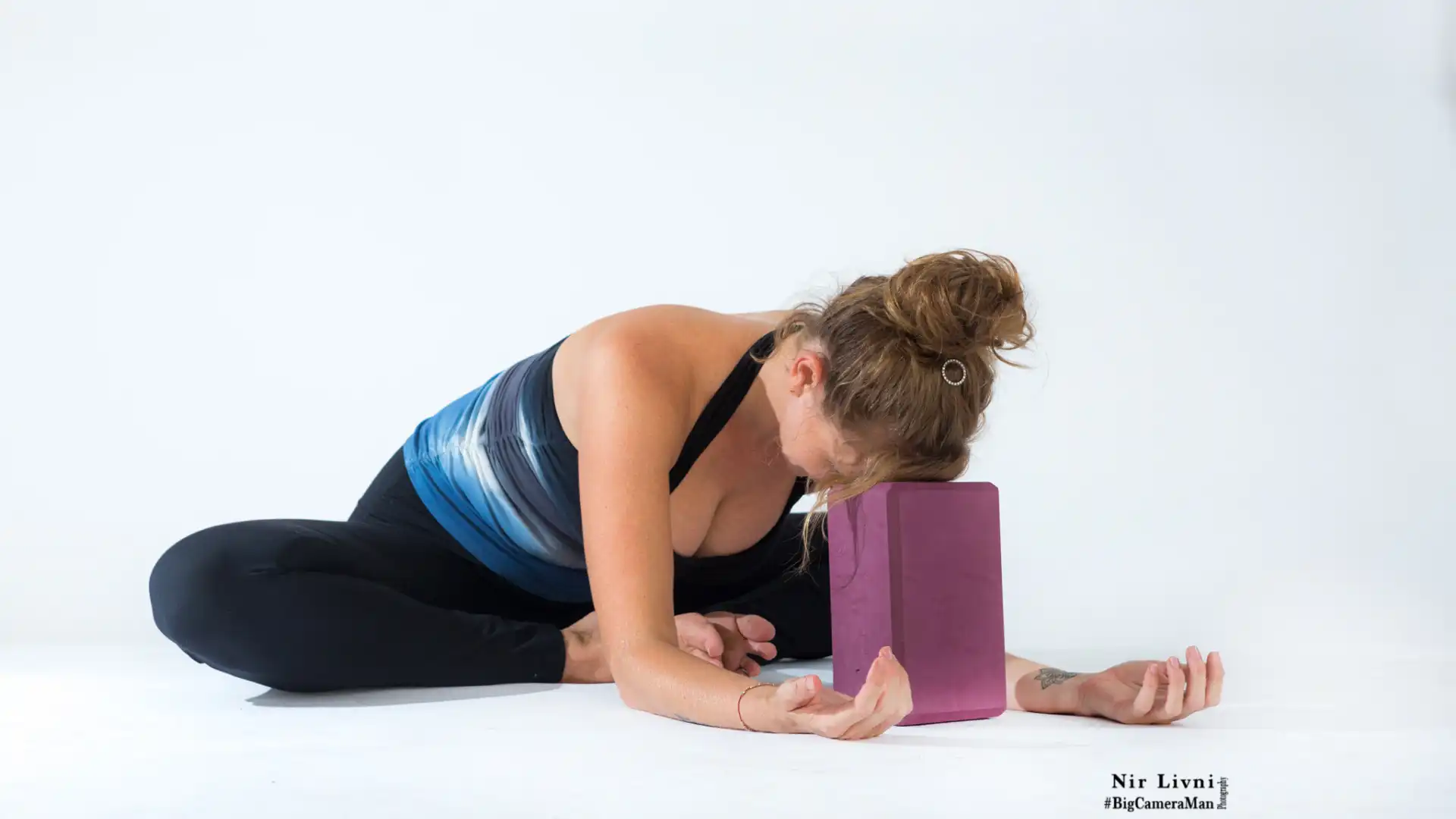
1. Sitting upright on your sitting bones or with your hips raised on a blanket or cushion if your hips and groins are tight. Bring the bottoms of your feet together, allowing your knees to fall open to the sides.
2. Grab ahold of the front of your ankle bones (not your toes), firmly press the outer edges of your feet together, and on an inhale, lengthen up through your spine, releasing your inner thighs and groins down to the floor in front of you.
3. Allow your belly to soften forward as well, and begin to hinge forward on an exhalation, walking the hands forward as necessary.
Stretching the inner thighs and releasing the groins, Bound Angle Pose helps create space in the lower back while relaxing the abdomen (in this variation). Forward folding lightly massages the pelvic and lower abdomen region, sometimes helping to alleviate heavy bleeding and cramping.
5. Supported Bridge PosE to Ease Menstrual Discomfort

1. Place both feet flat on the floor, hip distance apart under each knee, and rest your arms down by your sides.
2. Press down firmly through both feet, slowly lift up through your hips and slide a block—flat or on its side—underneath your sacrum (the hard, boney triangle of fused vertebrae at the bottom of your spine just above the flesh of your butt).
3. Turn your palms up and lightly wrap your shoulders underneath you. Make sure your pelvis is fully supported, release all of your weight into the block, and breathe. Feel free to stay anywhere from 2-5 minutes and then press firmly down into both feet to lift the hips back up and take the block out.
4. Slowly release your hips back to the floor, lowering each vertebra back down to the mat.
Particularly calming and rejuvenating for those with low energy, Supported Bridge Pose is an ideal way to release the lower back and muscles on either side of the sacrum. Really let go, completely relaxing your abdomen and allowing everything to rest back on the support of your cushions. It may be nice to place a warm heating pad over your lower belly while you rest.
6. Two-Knee Supine Twist
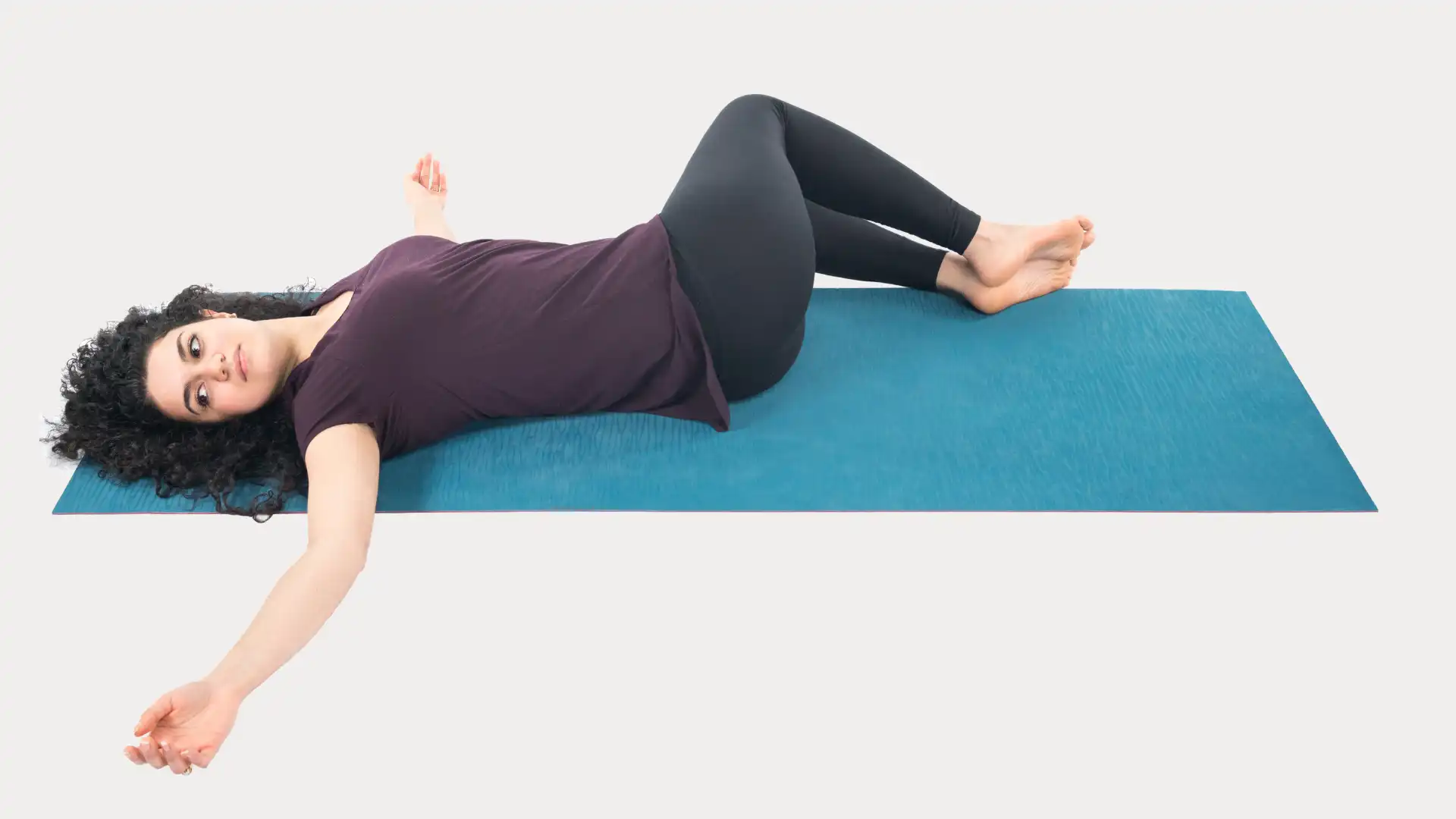
1. Lying on your back, gently hug your knees into your chest. Feel free to stay in this position for a few breaths.
2. When you’re ready, open your arms out to the sides in line with your shoulders (in the shape of a “T”), and on an exhale, gently drop both knees over toward your right armpit. Allow the knees to softly land where they will, sliding the bolster underneath as needed for support. Try to soften completely and deepen your breath.
A Two-Knee Supine Twist helps gently relieve pressure and smooth lower back pain while helping ease cramps.
3. When ready, lightly bring your knees back to the center and exhale them over to the other side.
7. Restorative Pose for Menstrual Discomfort: Supported Reclined Bound Angle Pose
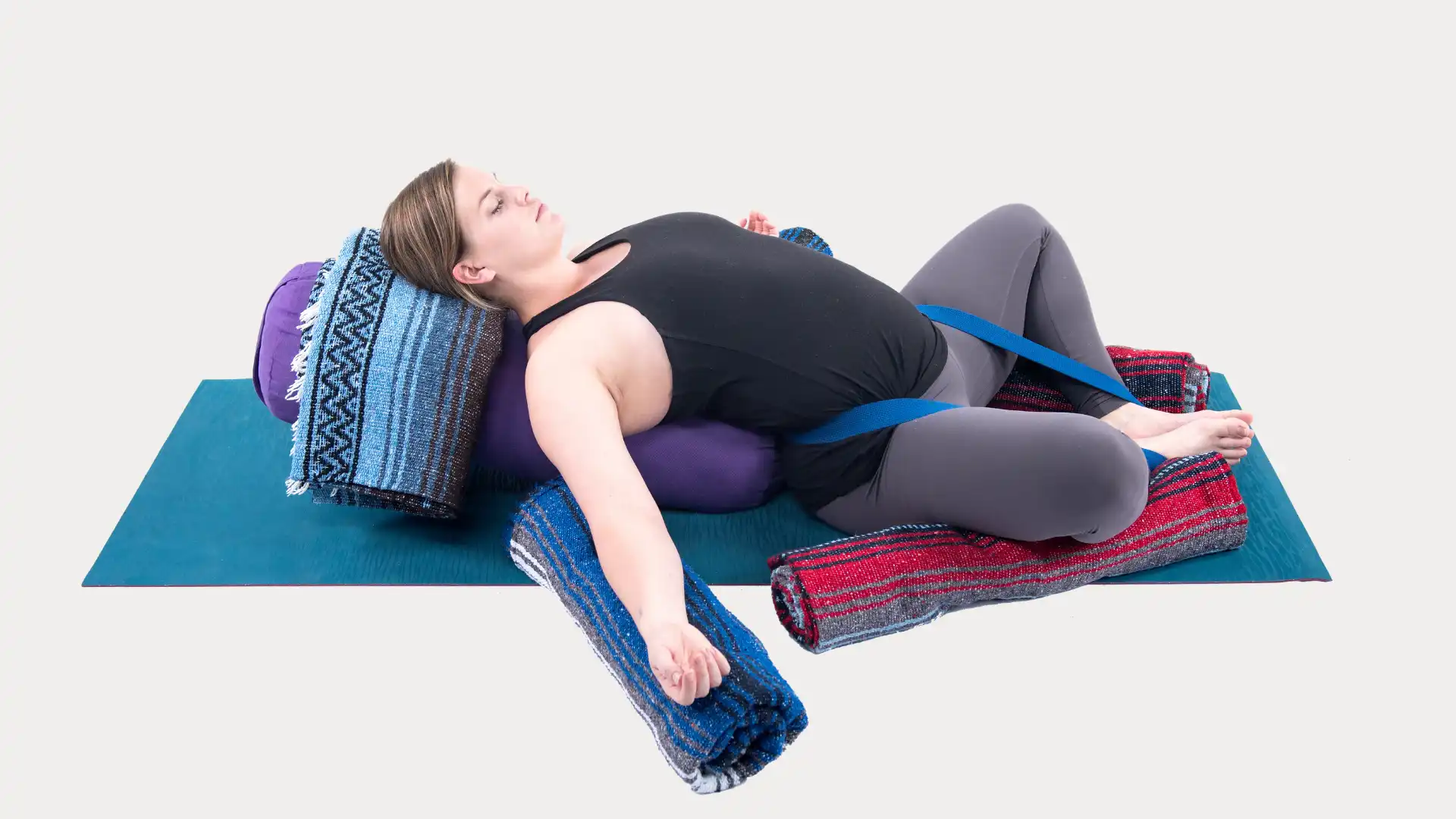
1. Placing your bolster or cushion lengthwise, sit on the floor in front of the bolster with the lowest part of your back against the short edge of the bolster.
2. Slowly begin to lower your back and head down to the bolster.
3. Once you’re fully supported by the bolster, bring the bottoms of your feet together and knees wide to the sides for reclined bound angle pose.
4. If you have two pillows around, slide one under each outer thigh for more support, allowing your groins to soften.
This restorative position is every woman’s dream, especially for menstrual discomfort and also during pregnancy. It releases the muscles around the pelvis and lower back, allowing the abdomen to soften and encouraging relaxation of the uterus. Stay in this position for as long as you like. Resting your hands on your lower abdomen or placing an extra blanket over the front of the pelvis is often comforting.
Another helpful article from YogaUOnline and Meagan McCrary – Yoga For Headaches: 3 Ways To Use The Foam Roller To Release Tension.
Also, read...
Which Is the Best Way to Come Into Triangle Pose?
Cat-Cow Pose (Marjaryasana-Bitilasana)
2 Restorative Yoga Poses to Calm Your Body and Mind
Related courses

Meagan McCrary is an experienced yoga teacher (E-RYT 500) and writer with a passion for helping people find more comfort, clarity, compassion, and joy on the mat and in their lives. She is the author of Pick Your Yoga Practice: Exploring and Understanding Different Styles of Yoga, a comprehensive encyclopedia of prominent yoga styles, including each system’s teaching methodology, elements of practice, philosophical and spiritual underpinnings, class structure, physical exertion and personal attention. Currently living in Los Angeles, Meagan teaches at the various Equinox Sports Clubs, works privately with clients and leads retreats internationally. You can find her blog, teaching schedule, and latest offerings at www.meaganmccrary.com



